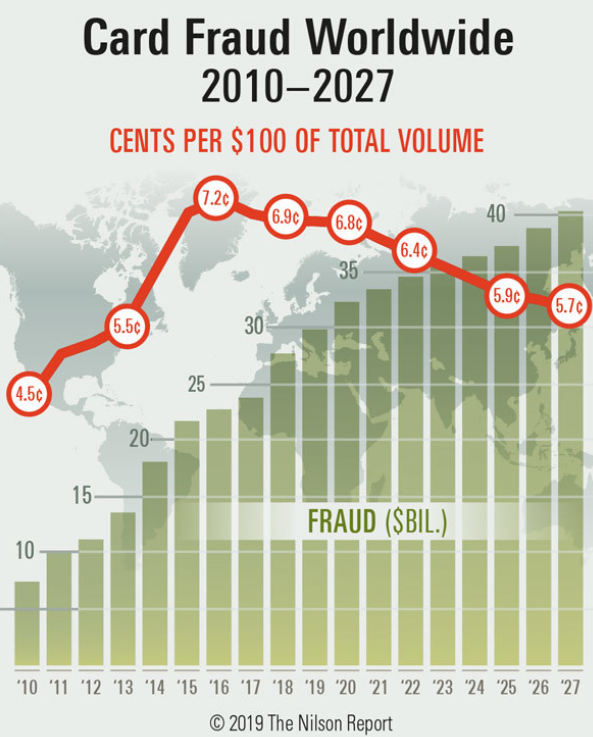
Trends

During this time of Covid-19 upheaval that is putting a significant strain on travel, protecting your revenue is more important than ever.
First, Let’s Talk About Fraud in Travel.
Per the 2019 The Nilson Report, credit-card fraud losses worldwide reached $27.85 billion in 2018 and are projected to keep rising to $35.67 billion in five years and to $40.63 billion in 10 years. The current fraud environment estimates that 46% of all fraudulent transactions are carried out in the travel industry which means $16 billion in losses.
Try a Simple Exercise.
To emphasize the damage of fraud in the travel industry, imagine that you gave away 6%–7% of each $100 of revenue to fraudsters. What do those losses look like at the end of a week, a month, or a year?
Credit-card fraud poses a large, prevalent challenge with two distinct ways to categorize it:
In a recent webinar, Nick Haggerty, an Inntopia Strategic Account Manager, said, “I hear from many people in the resort industry that they are seeing a doubling of chargebacks over the last two years and we know chargebacks are an increasing challenge.”
To defend against friendly fraud chargebacks, the right security tools must be in place at the time of the transaction. To successfully win back revenue from a disputed chargeback, enhanced security features such as CVV and AVS are the starting point. If a payment gateway lacks those enhanced security features and that information isn’t collected when processing a transaction, then merchants really don’t have a chance at winning back revenue.
Good News?
There is some good news in that fraud-attack increases in the travel industry are pacing lower at 19%, compared to other industries that are pacing at increases of 70%. This lower percentage shows that the strategies implemented by the travel industry to lower their risk compared to other industries, such as food and beverage and electronics, are working.
How Do You Lower Your Risk?
It’s all about the strategy you take. A great way to think about a strong fraud prevention strategy is to use Castle doctrine. In the defenses of a castle, there are many layered protections in place to prevent a breach, such as a moat, bridge, walls, and turrets. To stop invaders at multiple access points, you need a multitude of defenses.
In the case of revenue protection, the transaction is the castle; your protective measures are to exchange information. The more information you exchange with your customers about a transaction, the more protections/defenses you have against fraudsters. For even greater protection, you can implement more tools in the industry such as AVS, CVV, and building the reliability of the transaction with more information layers. You can go even further with third-party tools that provide curated analysis of a transaction which matches an IP address to a credit-card address. We’ll talk more about this a bit later in this post.
Gathering all these data points around a transaction help to mitigate the risk: expiration date, card number, issuer verification, CVV, AVS, third-party tools, and putting in place company policies and staff training around refunds, builds better defense layers and a strategy for fraud prevention. Nothing will be 100% but these measures can prevent or reduce a good portion of fraud losses.
What is Inntopia Doing?
Inntopia has spent a lot of time and effort using different methods and partnerships to build enhanced security. Learn how Inntopia protects its own eCommerce applications:
PCI Certification
ISO 27001 Security Certification
What about Payment Gateways?
Most people pick a payment gateway and stick with it, which is similar to how some people work with an insurance provider. If you think about your payment gateway like an insurance policy, it should have all the features, or “coverage,” that you need. When you sign up for a payment gateway, make sure the available features will support your eCommerce security requirements. Not all payment gateways are created equally and if you find that your payment gateway isn’t supporting you with the right security features, then change it to one that does. You’ll benefit by making sure your payment gateways offers you the correct levels of security.
Currently, Inntopia is engaged with four services that allow for CVV enhanced security.
Offer PayPal© as a Payment Option.
Another current Inntopia payment option is PayPal©. Not only does PayPal© function as a payment gateway, they also function as a full-service provider that provides seller protection for merchants.
Coming Soon: A Payment Option That Reduces Your Chargeback Risk.
Coming this fall for Inntopia Commerce clients is affirm©, a loan company that allows users to buy goods or services offered by online merchants and then pay off those purchases in fixed monthly payments. The benefits for customers that use affirm© are that they don’t charge late fees, service fees, pre-payment fees, or any other hidden fees. For merchants using affirm© as a payment option for their customers, affirm© settles payments with the merchant within one business day and takes on risk, from costly chargebacks to fraud.
Where Do We Want to Go and Why?
Fraudsters are turning to bots, Artificial Intelligence (AI), and computer-run programs to steal more. The future of preventing fraud is using AI and automation to fight back. You can beat them at their own game using the same technology.
Inntopia is especially interested in services that provide curated analysis through automation of geo location of the purchaser, purchase velocity, where device transactions originate, and also provide a mix of manual, automated, and AI learning. On the horizon and beyond, Inntopia is looking into third-party providers that will use AI-driven security automations and fraud mitigation to help our partners and clients avoid costly fraud exposure.